Serbs
| Total population | |||||||||||||||||
|---|---|---|---|---|---|---|---|---|---|---|---|---|---|---|---|---|---|
c.10 million*
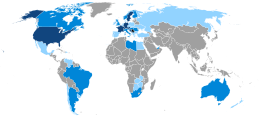 | |||||||||||||||||
| Regions with significant populations | |||||||||||||||||
| Other regions | |||||||||||||||||
| |||||||||||||||||
| |||||||||||||||||
| |||||||||||||||||
| |||||||||||||||||
| |||||||||||||||||
| |||||||||||||||||
| |||||||||||||||||
| Languages | |||||||||||||||||
| Serbian | |||||||||||||||||
| Religion | |||||||||||||||||
| PredominantlyEastern Orthodoxy (Serbian Orthodox Church)[27] | |||||||||||||||||
| Related ethnic groups | |||||||||||||||||
| South Slavs | |||||||||||||||||
*The total figure is merely an estimation; sum of all the referenced populations. **Some 265,895 (or 42.88% of Montenegro's total population) declared Serbian language as their mother tongue.[28] | |||||||||||||||||
| Part ofa serieson |
| Serbs |
|---|
 |
TheSerbs(Serbian Cyrillic:Срби,romanized:Srbi,pronounced[sr̩̂bi]) are aSouth Slavicethnic groupnative toSoutheastern Europewho share a common Serbianancestry,culture,history,andlanguage.[29][30][31][32]They primarily live inSerbia,Kosovo,Bosnia and Herzegovina,Croatia,Montenegroas well as inNorth Macedonia,Slovenia,GermanyandAustria.They also constitute a significantdiasporawith several communities acrossEurope,theAmericasandOceania.[33][34]
The Serbs share many cultural traits with the rest of the peoples ofSoutheast Europe.They are predominantlyEastern Orthodox Christiansby religion. TheSerbianlanguage (a standardized version ofSerbo-Croatian) is official in Serbia, co-official in Kosovo and Bosnia and Herzegovina, and is spoken by the plurality in Montenegro.
Ethnology
The identity of Serbs is rooted inEastern Orthodoxyand traditions. In the 19th century, theSerbian national identitywas manifested,[35]with awareness of history and tradition, medieval heritage, cultural unity, despite living under different empires.[citation needed]Three elements, together with the legacy of theNemanjić dynasty,were crucial in forging identity and preservation during foreign domination: theSerbian Orthodox Church,theSerbian language,and theKosovo Myth.[36]When thePrincipality of Serbiagained independence from the Ottoman Empire, Orthodoxy became crucial in definingthe national identity,instead of language which was shared by otherSouth Slavs(CroatsandBosniaks).[37]The tradition ofslava,the family saint feast day, is an important ethnic marker of Serb identity,[38]and is usually regarded their most significant and most solemnfeast day.[39]
The origin of theethnonymis unclear. The most prominent theory considers it ofProto-Slavicorigin.Hanna Popowska-Taborska[bg;pl]argued nativeSlavicprovenance of the ethnonym,[40]claiming that the theory advances a conclusion that the ethnonym has a meaning of a family kinship or alliance, which was also argued by a number of other scholars.[41]
Genetic origins
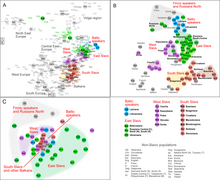
According to a triple analysis –autosomal,mitochondrialandpaternal— of available data from large-scale studies onBalto-Slavsand their proximal populations, the whole genomeSNPdata situates Serbs with Montenegrins in between two Balkan clusters.[42]Y-DNA results show that haplogroupsI2aandR1atogether stand for the majority of the makeup, with more than 53 percent.[43][44]The aforementioned Serbian Y-chromosomes belong to lineages believed to be pre-Neolithic.Such significant levels are possibly the result of Neolithic migrations encroaching on Paleolithic populations against the Adriatic Sea.[45]
According to several recent studies Serbia's people are among the tallest in the world,[46]with an averagemale heightof 1.82 metres (6 ft 0 in).[47][48]
History
Arrival of the Slavs
Early Slavs,especiallySclaveniandAntae,including theWhite Serbs,invaded and settledSoutheastern Europein the 6th and 7th century.[49]Up until the late 560s, their activity was raiding, crossing from the Danube, though with limited Slavic settlement mainly through Byzantinefoederaticolonies.[50]TheDanubeandSavafrontier was overwhelmed by large-scale Slavic settlement in the late 6th and early 7th century.[51]What is todaycentral Serbiawas an important geo-strategical province, through which theVia Militariscrossed.[52]This area was frequently intruded bybarbariansin the 5th and 6th centuries.[52]The numerous Slavs mixed with and assimilated the descendants of the indigenous population (Illyrians, Thracians, Dacians, Romans, Celts).[53]White Serbs fromWhite Serbiacame toan area near Thessalonikiand then they settled area between Dinaric Alps and Adriatic coast.[54]The region of "Rascia" (Raška) was the center of Serb settlement and Serb tribes also occupied parts of modern-dayHerzegovinaandMontenegro.[55]Prior to their arrival to the Balkans, early Slavs were predominantly involved in agriculture, which is why they settled in areas which were cultivated even during Roman times.[56]
Middle Ages

The first Serb states,Serbia(780–960) andDuklja(825–1120), were formed chiefly under theVlastimirovićandVojislavljevićdynasties respectively.[57][58]The other Serb-inhabited lands, or principalities, that were mentioned included the "countries" ofPaganija,Zahumlje,Travunija.[59][60]With the decline of the Serbian state of Duklja in the late 11th century, Raška separated from it and replaced it as the most powerful Serbian state.[61]PrinceStefan Nemanja(r. 1169–96) conquered the neighbouring territories ofKosovo,DukljaandZachlumia.TheNemanjić dynastyruled over Serbia until the 14th century. Nemanja's older son,Stefan Nemanjić,became Serbia's first recognized king, while his younger son, Rastko, founded theSerbian Orthodox Churchin the year 1219, and became known asSaint Savaafter his death.[62]Parts of modern-day Montenegro,Bosnia and Herzegovina,and central Serbia would come under the control of Nemanjić.[63]
Over the next 140 years, Serbia expanded its borders, from numerous smaller principalities, reaching to a unifiedSerbian Empire.Its cultural model remained Byzantine, despite political ambitions directed against the empire. The medieval power and influence of Serbia culminated in the reign ofStefan Dušan,who ruled the state from 1331 until his death in 1355. Ruling as Emperor from 1346, his territory includedMacedonia,northern Greece, Montenegro, and almost all of modernAlbania.[64]When Dušan died, his sonStephen Uroš Vbecame Emperor.[65]
WithTurkishinvaders beginning their conquest of the Balkans in the 1350s, a major conflict ensued between them and the Serbs, the first major battle was theBattle of Maritsa(1371),[65]in which the Serbs were defeated.[66]With the death of two important Serb leaders in the battle, and with the death of Stephen Uroš that same year, theSerbian Empirebroke up into several small Serbian domains.[65]These states were ruled by feudal lords, with Zeta controlled by theBalšić family,Raška,Kosovoand northern Macedonia held by theBranković familyandLazar Hrebeljanovićholding today'sCentral Serbiaand a portion of Kosovo.[66]Hrebeljanović was subsequently accepted as the titular leader of the Serbs because he was married to a member of the Nemanjić dynasty.[65]In 1389, the Serbs faced the Ottomans at theBattle of Kosovoon the plain ofKosovo Polje,near the town ofPriština.[66]Both Lazar andSultanMurad Iwere killed in the fighting.[66]The battle most likely ended in a stalemate, and afterwards Serbia enjoyed a short period of prosperity under despotStefan Lazarevićand resisted falling to the Turks until 1459.[66]
Early modern period
The Serbs had taken an active part in the wars fought in the Balkans against the Ottoman Empire, and also organized uprisings;[67][68]because of this, they suffered persecution and their territories were devastated – major migrations from Serbia into Habsburg territory ensued.[69]After allied Christian forceshad captured Budafrom the Ottoman Empire in 1686 during theGreat Turkish War,Serbs fromPannonian Plain(present-dayHungary,Slavoniaregion in present-dayCroatia,BačkaandBanatregions in present-daySerbia) joined the troops of the Habsburg monarchy as separate units known asSerbian Militia.[70]Serbs, as volunteers, massively joined the Austrian side.[71]

Many Serbs were recruited during thedevshirmesystem, a form ofslavery in the Ottoman Empire,in which boys from Balkan Christian families wereforcibly convertedtoIslamand trained for infantry units of theOttoman armyknown as theJanissaries.[72][73][74][75]A number of Serbs who converted to Islam occupied high-ranking positions within theOttoman Empire,such asGrand VizierSokollu Mehmed PashaandMinister of Warfield marshalOmar Pasha Latas.
In 1688,the Habsburg army took Belgradeand entered the territory of present-dayCentral Serbia.Louis William, Margrave of Baden-Badencalled Serbian PatriarchArsenije III Čarnojevićto raise arms against the Turks; the Patriarch accepted and returned to the liberated Peć. As Serbia fell under Habsburg control, Leopold I granted Arsenije nobility and the title of duke. In early November, Arsenije III met with Habsburg commander-in-chief,General Enea Silvio PiccolominiinPrizren;after this talk he sent a note to all Serb bishops to come to him and collaborate only with Habsburg forces.
AGreat Migration of the Serbs (1690)to Habsburg lands was undertaken by Patriarch Arsenije III.[76]The large community of Serbs concentrated in Banat, southern Hungary and the Military Frontier included merchants and craftsmen in the cities, but mainly refugees that were peasants.[76]Smaller groups of Serbs also migrated to theRussian Empire,where they occupied high positions in the military circles.[77][78][79]
TheSerbian Revolutionfor independence from the Ottoman Empire lasted eleven years, from 1804 until 1815.[80]The revolution comprised two separate uprisings which gained autonomy from the Ottoman Empire that eventually evolved towards full independence (1835–1867).[81][82]During theFirst Serbian Uprising,led by DukeKarađorđe Petrović,Serbia was independent for almost a decade before the Ottoman army was able to reoccupy the country. Shortly after this, theSecond Serbian Uprisingbegan. Led byMiloš Obrenović,it ended in 1815 with a compromise between Serbian revolutionaries and Ottoman authorities.[83]Likewise, Serbia was one of the first nations in the Balkans to abolishfeudalism.[84]Serbs are among the first ethnic groups in Europe to form anationand a clear sense of national identity.[85]
Modern period
In the early 1830s, Serbia gained autonomy and its borders were recognized, withMiloš Obrenovićbeing recognized as its ruler. Serbia is the fourth modern-day European country, after France, Austria and the Netherlands, to have a codified legal system, as of 1844.[86]The last Ottoman troops withdrew from Serbia in 1867, although Serbia's and Montenegro's independence was not recognized internationally until theCongress of Berlinin 1878.[69]
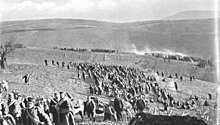
Serbia fought in theBalkan Warsof 1912–13, which forced the Ottomans out of the Balkans and doubled the territory and population of theKingdom of Serbia.In 1914, a youngBosnian Serbstudent namedGavrilo PrincipassassinatedArchduke Franz Ferdinand of Austria,which directly contributed to the outbreak ofWorld War I.[87]In the fighting that ensued, Serbia was invaded byAustria-Hungary.Despite being outnumbered, the Serbs defeated the Austro-Hungarians at theBattle of Cer,which marked the firstAlliedvictory over theCentral Powersin the war.[88]Further victories at the battles ofKolubaraand theDrinameant that Serbia remained unconquered as the war entered its second year. However, an invasion by the forces ofGermany,Austria-HungaryandBulgariaoverwhelmed the Serbs in the winter of 1915, and a subsequent withdrawal by theSerbian Armythrough Albania took the lives of more than 240,000 Serbs. Serb forces spent the remaining years of the war fighting on theSalonika frontin Greece, before liberating Serbia fromAustro-Hungarian occupationin November 1918.[89]Serbia sufferedthe biggest casualty rate in World War I.[90]
Following the victory in WWI, Serbs subsequently formed theKingdom of Serbs, Croats and Sloveneswith otherSouth Slavic peoples.The country was later renamed theKingdom of Yugoslavia,and was led from 1921 to 1934 by KingAlexander Iof the SerbianKarađorđević dynasty.[91]DuringWorld War II,Yugoslavia was invaded by theAxis powersin April 1941. The country was subsequently divided into many pieces, with Serbia being directly occupied by the Germans.[92]Serbs in theIndependent State of Croatia(NDH) were targeted for extermination as part ofgenocideby the Croatian ultra-nationalist, fascistUstaše.[93][94][95][96]The Ustaše view of national and racial identity, as well as the theory of Serbs as aninferior race,was under the influence ofCroatian nationalistsand intellectuals from the end of the 19th and the beginning of the 20th century.[97][98][99]Jasenovac campwas notorious for the barbaric practices which occurred in it.[94]SisakandJastrebarsko concentration campwere speciallyformed for children.[100][101][102]Serbs in the NDH suffered among the highest casualty rates in Europe during the World War II, while the NDH was one of the most lethal regimes in the 20th century.[103][104][105]Diana Budisavljević,a humanitarian of Austrian descent, carried out rescue operations from Ustaše camps and saved more than 15,000 children, mostly Serbs.[106][107]

More than half a million Serbs were killed in the territory of Yugoslavia during World War II. Serbs in occupied Yugoslavia subsequently formed a resistance movement known as theYugoslav Army in the Homeland,or the Chetniks. The Chetniks had the official support of theAlliesuntil 1943, when Allied support shifted to the CommunistYugoslav Partisans,a multi-ethnic force, formed in 1941, which also had a large majority of Serbs in its ranks in the first two years of war. Over the entirety of the war, the ethnic composition of the Partisans was 53 percent Serb.[108][109]During the entire course of the WWII in Yugoslavia, 64.1% of all Bosnian Partisans were Serbs.[110]Later, after the fall of Italy in September 1943, other ethnic groups joined Partisans in larger numbers.[92]
At the end of the war, the Partisans, led byJosip Broz Tito,emerged victorious. Yugoslavia subsequently became a Communist state. Tito died in 1980, and his death sawYugoslaviaplunge into economic turmoil.[111]Yugoslaviadisintegratedin the early 1990s, and aseries of warsresulted in the creation of five new states. The heaviest fighting occurred inCroatia,Bosnia and Herzegovina,whose Serb populations rebelled and declared independence. Thewarin Croatia ended in August 1995, with a Croatian military offensive known asOperation Stormput a stop to theCroatian Serbrebellion and causing as many as 200,000 Serbs to flee the country. TheBosnian Warended that same year, with theDayton Agreementdividing the country along ethnic lines. In 1998–99, aconflictin Kosovo between the Yugoslav Army and Albanians seeking independence erupted into full-out war, resulting in a 78-day-longNATO bombing campaignwhich effectively drove Yugoslav security forces from Kosovo.[112]Subsequently, more than 200,000 Serbs and other non-Albanians fled the province.[113]On 5 October 2000, YugoslavPresidentSlobodan Milosevićwas overthrown in a bloodless revolt after he refused to admit defeat in the2000 Yugoslav general election.[114]
Demographics

Modern demographic distribution of ethnic Serbs throughout homeland and native regions, as well as inSerbian ethnic diaspora,represents an outcome of several historical and demographic processes, shaped both byeconomic migrationsandforced displacementsduring the recentYugoslav Wars(1991–1999).
Balkans
There are nearly 8 million Serbs living in their native homelands, within the geographical borders of formerYugoslavia.In Serbia itself, around 6 million people identify themselves as ethnic Serbs, and constitute about 83% of the population. More than a million live inBosnia and Herzegovina(predominantly in theRepublika Srpska), where they are one of the threeconstituent ethnic groups.Serbs inCroatia,MontenegroandNorth Macedoniaalso have recognized collective rights, and number some 186,000, 178,000 and 39,000 people, respectively, while another estimated 96,000 live in the disputed area ofKosovo.[4]Smaller minorities exist inSlovenia,some 36,000 people, respectively.
Outside of the former Yugoslavia, but within their historical and migratory areal, Serbs are officially recognized as national minority inAlbania,[115]Romania(18,000),Hungary(7,000), as well as in theCzech RepublicandSlovakia.
Diaspora
There are over 2 million Serbs indiasporathroughout the world; some sources put that figure as high as 4 million.[116]There is a large diaspora in Western Europe, particularly inGermany,Austria,Switzerland,France,Italy,SwedenandUnited Kingdom.Outside Europe, there are significant Serb communities in theUnited States,Canada,Australia,South AmericaandSouthern Africa.The existence of a large diaspora is mainly a consequence of either economic or political (coercionor expulsions) reasons. There were several waves of Serb emigration:
- The first wave took place since the end of the 19th century and lasted untilWorld War IIand was caused by economic reasons; particularly large numbers of Serbs (mainly from peripheral ethnic areas such asHerzegovina,Montenegro,Dalmatia,andLika) emigrated to the United States.
- The second wave took place after the end ofWorld War II.At this time, members of royalistChetniksand other political opponents of communist regime fled the country mainly going overseas (United StatesandAustralia) and, to a lesser degree,United Kingdom.
- The third wave, by far the largest, consisted of economic emigration beginning in the 1960s when several Western European countries signed bilateral agreements with Yugoslavia, allowing the recruitment of industrial workers to those countries; this lasted until the end of the 1980s. The major destinations for migrants wereWest Germany,Austria,andSwitzerland,and to a lesser extentFranceandSweden.That generation of diaspora is collectively known asgastarbajteri,after Germangastarbeiter( "guest-worker" ), since most of the emigrants headed for German-speaking countries. These migrations left some parts of Serbia sparsely populated.[117]
- Later emigration took place during the 1990s, and was caused by both political and economic reasons. TheYugoslav warscaused many Serbs from Croatia and Bosnia and Herzegovina to leave their countries in the first half of the 1990s. Theeconomic sanctionsimposed on Serbia caused an economic collapse with an estimated 300,000 people leaving Serbia during that period, 20% of which had a higher education.[118][119]
Language
Serbs speakSerbian,a member of theSouth Slavicgroup of languages, specifically the Southwestern group. Standard Serbian is a standardizedvarietyofSerbo-Croatian,and thereforemutually intelligiblewith StandardCroatian,StandardMontenegrin,and StandardBosnian(seeComparison of standard Bosnian, Croatian, Montenegrin and Serbian), which are all based on theShtokavian dialect.[120]

Serbian is an official language in Serbia and Bosnia-Herzegovina and is a recognized minority language in Montenegro (although spoken by a plurality of population), Croatia, North Macedonia, Romania, Hungary, Czech Republic and Slovakia. Older forms of literary Serbian areChurch Slavonicof the Serbian recension, which is still used for ecclesiastical purposes, andSlavonic-Serbian—a mixture of Serbian,Church SlavonicandRussianused from the mid-18th century to the first decades of the 19th century.
Serbian has activedigraphia,using bothCyrillicandLatinalphabets.[122]Serbian Cyrillicwas devised in 1814 by Serbian linguistVuk Karadžić,who created the alphabet on phonemic principles.[123]Serbian Latin was created byLjudevit Gajand published in 1830. His alphabet mapped completely on Serbian Cyrillic which had been standardized byVuk Karadžića few years before.[124]
Loanwords in the Serbian language besides common internationalisms are mostly fromGreek,[125]German[126]and Italian,[127]while words ofHungarianorigin are present mostly in the north.
TheOttoman conquestbegan a linguistical contact between Ottoman Turkish and South Slavic; Ottoman Turkish influence grew stronger after the 15th century.[128]Besides Turkish loanwords, also many Arabic (such asalat,"tool",sat,"hour, clock" ) and Persian (čarape,"socks",šećer,"sugar" ) words entered via Turkish, called "Orientalisms" (orijentalizmi).[128]Also, many Greek words entered via Turkish.[128]Words for hitherto unknown sciences, businesses, industries, technologies and professions were brought by the Ottoman Empire.[128]Christian villagers brought urban vocabulary from their travels to Islamic culture cities.[129]Many Turkish loanwords are no longer considered loanwords.[130]
There is considerable usage of French words as well, especially in military related terms.[126]One Serbian word that is used in many of the world's languages is "vampire"(vampir).[131][132][133][134]
Culture
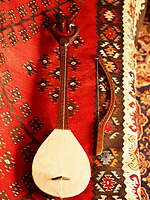
Literature,iconpainting, music, dance and medieval architecture are the artistic forms for which Serbia is best known. TraditionalSerbian visual art(specificallyfrescoes,and to some extenticons), as well as ecclesiastical architecture, are highly reflective of Byzantine traditions, with some Mediterranean and Western influence.[135]
Many Serbian monuments and works of art have been lost forever due to various wars and peacetime marginalizations.[136]
In modern times (since the 19th century) Serbs also have a noteworthyclassical musicand works of philosophy.[137]Notable philosophers includeSvetozar Marković,Branislav Petronijević,Ksenija Atanasijević,Radomir Konstantinović,Nikola Milošević,Mihailo Marković,Justin PopovićandMihailo Đurić.[138]
Art, music, theatre, and cinema
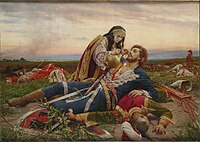
During the 12th and 13th centuries, many icons, wall paintings and manuscript miniatures came into existence, as many Serbian Orthodox monasteries and churches such asHilandar,Žiča,Studenica,Sopoćani,Mileševa,GračanicaandVisoki Dečaniwere built.[139]The architecture of some of these monasteries is world-famous.[62]Prominent architectural styles in the Middle Ages wereRaška architectural school,Morava architectural schoolandSerbo-Byzantin architectural style.During the same periodUNESCOprotectedStećakmonumental medieval tombstones were built. The Independence of Serbia in the 19th century was soon followed withSerbo-Byzantine Revivalin architecture.
Baroqueandrococotrends in Serbian art emerged in the 18th century and are mostly represented in icon painting and portraits.[140]Most of the Baroque authors were from the territory ofAustrian Empire,such asNikola Nešković,Teodor Kračun,Teodor Ilić Češljar,Zaharije OrfelinandJakov Orfelin.[141][142]Serbian painting showed the influence ofBiedermeierandNeoclassicismas seen in works byKonstantin Danil[143]andPavel Đurković.[144]Many painters followed the artistic trends set in the 19th century Romanticism, notablyĐura Jakšić,Stevan Todorović,Katarina IvanovićandNovak Radonić.[145][146]Since the mid-1800s, Serbia has produced a number of famous painters who are representative of general European artistic trends.[139]One of the most prominent of these wasPaja Jovanović,who painted massive canvases on historical themes such as theMigration of the Serbs(1896). PainterUroš Predićwas also prominent in the field of Serbian art, painting theKosovo MaidenandHappy Brothers.While Jovanović and Predić were bothrealistpainters, artistNadežda Petrovićwas animpressionistandfauvistandSava Šumanovićwas an accomplishedCubist.PaintersPetar Lubarda,Vladimir VeličkovićandLjubomir Popovićwere famous for theirsurrealism.[147]Marina Abramovićis a world-renownedperformance artist,writer, andart filmmaker.[148]
Traditional Serbian music includes various kinds ofbagpipes,flutes,horns,trumpets,lutes,psalteries,drumsandcymbals.[149]Thekolois the traditional collective folk dance, which has a number of varieties throughout the regions. The first Serbian composers started working in the 14th and 15th century, likeKir Stefan the Serb.[150]Composer andmusicologistStevan Stojanović Mokranjacis considered one of the most important founders of modern Serbian music.[151][152]Other noted classical composers includeKornelije Stanković,Stanislav Binički,Petar Konjović,Miloje Milojević,Stevan Hristić,Josif Marinković,Luigi von Kunits,Ljubica Marić[153]andVasilije Mokranjac.[154]Well-known musicians includeZdravko Čolić,Arsen Dedić,Predrag Gojković-Cune,Toma Zdravković,Milan Mladenović,Radomir Mihailović Točak,Bora Đorđević,Momčilo Bajagić Bajaga,Đorđe Balašević,Cecaand others.
Serbia has produced many talented filmmakers, the most famous of whom areSlavko Vorkapić,Dušan Makavejev,[155]Živojin Pavlović,Slobodan Šijan,Goran Marković,Goran Paskaljević,Emir Kusturica,Želimir Žilnik,Srđan Dragojević,[156]Srdan GolubovićandMila Turajlić.Žilnik andStefan Arsenijevićwon theGolden Bearaward atBerlinale,while Mila Turajlić won the main award atIDFA.Kusturica became world-renowned after winning thePalme d'Ortwice at theCannes Film Festival,numerous other prizes, and is aUNICEFNational Ambassador for Serbia.[157]Several Americans of Serb origin have been featured prominently inHollywood.The most notable of these are Academy Award winnersKarl Malden,[158][159]Steve Tesich,Peter Bogdanovich,Tony-winning theatre directorDarko Tresnjak,Emmy-winning directorMarina Zenovichand actorsIván Petrovich,Brad Dexter,Lolita Davidovich,Milla JovovichandStana Katic.
| Orfelin (1726–1785) |
Mokranjac (1856–1914) |
Jovanović (1859–1957) |
Petrović (1873–1915) |
Malden (1912–2009) |
Bakić (1915–1992) |
Kusturica (1954) |
|---|---|---|---|---|---|---|

|

|

|

|
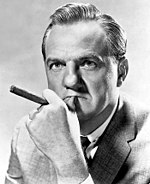
|
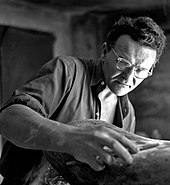
|

|
Literature
Most literature written by early Serbs was about religious themes. The founders of theSerbian Orthodox Churchwrote variousgospels,psalters,menologies,hagiographies,along with essays and sermons.[160]At the end of the 12th century, two of the most important pieces of Serbian medieval literature were created– theMiroslav Gospelsand theVukan Gospels,which combined handwritten Biblical texts with painted initials and small pictures.[62]TheCrnojević printing housewas the first printing house in Southeastern Europe and is considered an important part of Serbian cultural history.[161]
NotableBaroque-influenced authors wereAndrija Zmajević,Gavril Stefanović Venclović,Jovan Rajić,Zaharije Orfelinand others.Dositej Obradovićwas the most prominent figure of theAge of Enlightenment,while the most notable Classicist writer wasJovan Sterija Popović,although his works also contained elements of Romanticism. Modern Serbian literature began withVuk Karadžić's collections offolk songsin the 19th century, and the writings ofNjegošandBranko Radičević.The first prominent representative of Serbian literature in the 20th century wasJovan Skerlić,who wrote in pre–World War IBelgradeand helped introduce Serbian writers to literary modernism. The most important Serbian writer in theinter-war periodwasMiloš Crnjanski.[162]
The first Serb authors who appeared after World War II wereMihailo LalićandDobrica Ćosić.[163]Other notable post-war Yugoslav authors such asIvo AndrićandMeša Selimovićwere assimilated to Serbian culture, and both identified as Serbs.[162]Andrić went on to win theNobel Prize in Literaturein 1961.[163]Danilo Kiš,another popular Serbian writer, was known for writingA Tomb for Boris Davidovich,as well as several acclaimed novels.[164]Amongst contemporary Serbian writers,Milorad Pavićstands out as being the most critically acclaimed, with his novelsDictionary of the Khazars,Landscape Painted with TeaandThe Inner Side of the Windbringing him international recognition. Highly revered in Europe and inSouth America,Pavić is considered one of the most intriguing writers from the beginning of the 21st century.[165]Charles Simicis a notable contemporary Serbian-American poet, formerUnited States Poet Laureateand aPulitzer Prize winner.[166]Contemporary writerZoran Živkovićauthored more than 20 prose books and is best-known for hisSFworks which have been published in 23 countries.[167][168]
| Obradović (1739–1811) |
Popović (1806–1856) |
Petrović-Njegoš (1813–1851) |
Andrić (1892–1975) |
Crnjanski (1893–1977) |
Maksimović (1898–1993) |
Pekić (1930–1992) |
|---|---|---|---|---|---|---|
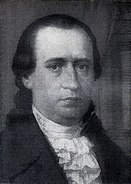
|
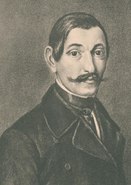
|
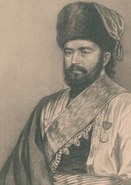
|
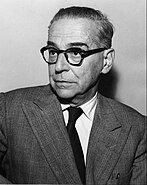
|

|

|
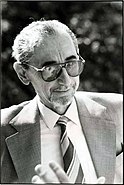
|
Education and science
Many Serbs have contributed to the field of science and technology. There are more Serbian scientists and scholars working abroad than in the Balkans. At least 7000 Serbs who have a PhD are working abroad.[169]
Serbian Americanmechanical and electrical engineerNikola Teslais regarded as one of the most important inventors in history. He is renowned for his contributions to the discipline of electricity and magnetism in the late 19th and early 20th century. Seven Serbian American engineers and scientists known asSerbo 7[170]took part in construction of theApollo spaceship.[171]Physicist and physical chemistMihajlo Pupinis best known for his landmark theory of modern electrical filters as well as for his numerous patents, whileMilutin Milankovićis best known for his theory of long-termclimate changecaused by changes in the position of the Earth in comparison to the Sun, now known asMilankovitch cycles.[172]Gordana Vunjak-Novakovicis a Serbian American biomedical engineer focusing on engineering human tissues forregenerative medicine,stem cellresearch and modeling of disease. She is one of the most highly cited scientists of all times.[173]
Notable Serb mathematicians includeMihailo Petrović,Jovan KaramataandĐuro Kurepa.Mihailo Petrović is known for having contributed significantly to differential equations and phenomenology, as well as inventing one of the first prototypes of an analog computer.Roger Joseph Boscovichwas a Ragusan physicist, astronomer, mathematician and polymath of paternal Serbian origin[174][175][176][177](although there are competing claims for Bošković's nationality) who produced a precursor ofatomic theoryand made many contributions toastronomyand also discovered theabsence of atmosphereon theMoon.Jovan Cvijićfounded modern geography in Serbia and made pioneering research on the geography of theBalkan Peninsula,Dinaric raceandkarst.Josif Pančićmade contributions tobotanyand discovered a number of new floral species including theSerbian spruce.[178]Biologist and physiologistIvan Đajaperformed research in the role of theadrenal glandsinthermoregulation,as well as pioneering work inhypothermia.[179][180] Valtazar Bogišićis considered to be a pioneer in thesociology of lawand sociological jurisprudence.
| Novaković (1842–1915) |
Tesla (1856–1943) |
Pupin (1858–1935) |
Cvijić (1865–1927) |
Petrović (1868–1943) |
Milanković (1879–1958) |
Kurepa (1907–1993) |
|---|---|---|---|---|---|---|
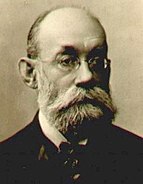
|
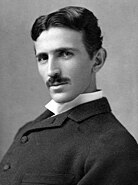
|
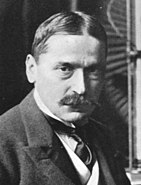
|

|

|
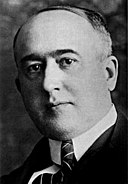
|
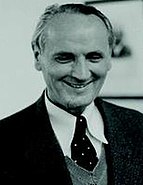
|
Names
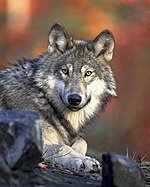
There are several different layers of Serbian names. Serbian given names largely originate fromSlavic roots: e.g.,Vuk,Bojan,Goran,Zoran,Dragan,Milan,Miroslav,Vladimir,Slobodan,Dušan,Milica,Nevena,Vesna,Radmila.Other names are of Christian origin, originating from the bible (Hebrew,through Greek), such asLazar,Mihailo,Ivan,Jovan,Ilija,Marija,Ana,Ivana.Along similar lines of non-Slavic Christian names areGreekones such as:Stefan,Nikola,Aleksandar,Filip,Đorđe,Andrej,Jelena,Katarina,Vasilije,Todor,while those ofLatinorigin include:Marko,Antonije,Srđan,Marina,Petar,Pavle,Natalija,Igor(through Russian).
Most Serbian surnames are paternal, maternal, occupational or derived from personal traits. It is estimated that over two thirds of all Serbian surnames have the suffix-ić(-ић) ([itɕ]), a Slavic diminutive, originally functioning to create patronymics. Thus the surnamePetrovićmeans the "son of Petar" (from a male progenitor, the root is extended with possessive-ovor-ev). Due to limited use of international typewriters and unicode computer encoding, the suffix may be simplified to-ic,historically transcribed with a phonetic ending,-ichor-itchin foreign languages. Other common surname suffixes found among Serbian surnames are-ov,-ev,-inand-ski(without-ić) which is the Slavicpossessive casesuffix, thus Nikola's son becomes Nikolin, Petar's son Petrov, and Jovan's son Jovanov. Other, less common suffices are-alj/olj/elj,-ija,-ica,-ar/ac/an.The ten most common surnames in Serbia, in order, areJovanović,Petrović,Nikolić,Marković,Đorđević,Stojanović,Ilić,Stanković,PavlovićandMilošević.[183]
Religion
Right:Church of Saint Sava,one of the largest Orthodox churches in the world
Serbs are predominantlyOrthodox Christians.Theautocephalyof theSerbian Orthodox Church,was established in 1219, as an Archbishopric, and raised to thePatriarchatein 1346.[184]It is led by theSerbian Patriarch,and consists of three archbishoprics, six metropolitanates and thirty-one eparchies, having around 10 million adherents. Followers of the church form the largest religious group in Serbia and Montenegro, and the second-largest inBosnia and HerzegovinaandCroatia.The church has an archbishopric inNorth Macedoniaand dioceses in Western Europe, North America, South America[185]and Australia.[186]
The identity of ethnic Serbs was historically largely based on Orthodox Christianity and on the Serbian Church in particular. The conversion of the South Slavs from paganism to Christianity took place before theGreat Schism.During the time of the Great Schism, Serbian rulers includingMihailo VojislavljevićandStefan Nemanjawere Catholics, with the former being a vassal of thePapal States.In 1217, the Serbian rulerStefan Nemanja IIwas crowned byPope Honorius IIIof the Catholic Church. However in 1219, Nemanja II was crowned once again by the newly independent Serbian Orthodox Church. This shift solidified the Christian Orthodox religion in Serbia.[187]
With the arrival of theOttoman Empire,some Serbs converted toIslam.This was particularly, but not wholly, the case inBosnia.[188]Since the second half of the 19th century, a small number of Serbs converted to Protestantism,[189]while historically some Serbs were Catholics (especially inBay of Kotor[190]andDalmatia;e.g.Serb-Catholic movement in Dubrovnik).[191]In a personal correspondence with author and critic dr. Milan Šević in 1932,Marko Muratcomplained that Orthodox Serbs are not acknowledging the Catholic Serb community on the basis of their faith.[192]The remainder of Serbs remain predominantly Serbian Orthodox Christians.
Symbols
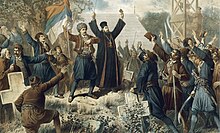
Among the most notable national and ethnic symbols are theflag of Serbiaand thecoat of arms of Serbia.The flag consists of a red-blue-whitetricolour,rooted inPan-Slavism,and has been used since the 19th century. Apart from being the national flag, it is also used officially inRepublika Srpska(by Bosnian Serbs) and as the official ethnicFlag of Serbs of Croatia.The coat of arms, which includes both theSerbian eagleandSerbian cross,has also been officially used since the 19th century, its elements dating back to the Middle Ages, showing Byzantine and Christian heritage. These symbols are used by various Serb organisations, political parties and institutions. TheThree-finger salute,also called the "Serb salute", is a popular expression for ethnic Serbs and Serbia, originally expressingSerbian Orthodoxyand today simply being a symbol for ethnic Serbs and the Serbian nation, made by extending the thumb, index, and middle fingers of one or both hands.
Traditions and customs

Traditional clothing varies due to diverse geography and climate of the territory inhabited by the Serbs. The traditional footwear,opanci,is worn throughout the Balkans.[193]The most commonfolk costume of Serbiais that ofŠumadija,a region in central Serbia,[194]which includes the national hat, theŠajkača.[195][196]Older villagers still wear their traditional costumes.[194]The traditional dance is thecircle dance,calledkolo.Zmijanje embroideryis a specific technique of embroidery practised by the women of villages in area Zmijanje on mountainManjačaand as such is a part of theUNESCO Representative List of the Intangible Cultural Heritage of Humanity.Pirot carpetis a variety of flat tapestry woven rug traditionally produced inPirot,a town in southeastern Serbia.
Slavais the family's annual ceremony and veneration of their patron saint, a social event in which the family is together at the house of the patriarch. The tradition is an important ethnic marker of Serb identity.[38]Serbs usually regard the Slava as their most significant and most solemnfeast day.[39] Serbs havetheir own customs regarding Christmas,which includes the sacral tree, thebadnjak,a youngoak.On OrthodoxEaster,Serbs have the tradition ofSlavic Egg decorating.Čuvari Hristovog grobais a religious/cultural practice of guarding a representation ofChrist's grave onGood Fridayin theChurch of St. Nicholasby theSerbian Orthodoxinhabitants in the town ofVrlika.[197]
Cuisine

Serbian cuisineis largely heterogeneous, with heavy Oriental, Central European and Mediterranean influences.[198]Despite this, it has evolved and achieved its own culinary identity. Food is very important in Serbian social life, particularly during religious holidays such asChristmas,Easterand feast days, i.e.,slava.[198]Staples of the Serbian diet include bread, meat, fruits, vegetables, and dairy products. Traditionally, three meals are consumed per day. Breakfast generally consists of eggs, meat and bread. Lunch is considered the main meal, and is normally eaten in the afternoon. Traditionally,Domestic or turkish coffeeis prepared after a meal, and is served in small cups.[198]Bread is the basis of all Serbian meals, and it plays an important role in Serbian cuisine and can be found in religious rituals. A traditional Serbian welcome is to offerbread and saltto guests,[199]and alsoslatko(fruit preserve). Meat is widely consumed, as is fish. Serbian specialties includekajmak(a dairy product similar toclotted cream),proja(cornbread),kačamak(corn-flour porridge), andgibanica(cheese and kajmak pie).Ćevapčići,caseless grilled and seasoned sausages made of minced meat, is thenational dishof Serbia.[198]
Šljivovica(Slivovitz) is the national drink of Serbia in domestic production for centuries, and plum is the national fruit. The international nameSlivovitzis derived from Serbian.[200]Plum and its products are of great importance to Serbs and part of numerous customs.[201]A Serbian meal usually starts or ends with plum products and Šljivovica is served as an aperitif.[201]A saying goes that the best place to build a house is where a plum tree grows best.[201]Traditionally, Šljivovica (commonly referred to as "rakija") is connected to Serbian culture as a drink used at all important rites of passage (birth, baptism, military service, marriage, death, etc.), and in theSerbian Orthodoxpatron saint celebration (slava).[201]It is used in numerous folk remedies, and is given certain degree of respect above all other alcoholic drinks. The fertile region ofŠumadijain central Serbia is particularly known for its plums and Šljivovica.[202]Serbia is the largest exporter of Slivovitz in the world, and second largest plum producer in the world.[203][204]Winemaking tradition in modern-day Serbia dates back to the Roman times in the 3rd century, while Serbs have been involved in winemaking since the 8th century.[205][206]
Sport
Serbs are known for their sporting achievements, and have produced a number of talented athletes.
TheHungariancitizenMomčilo Tapavicawas the firstSlavand Serb to win anOlympic medal,in the1896 Summer Olympics.[207][208]
Over the years Serbia has been home to many internationally successful football players such asDragan Džajić(officially recognized as "the best Serbian footballer of all times" by Football Association of Serbia; 1968Ballon d'Orthird place),Rajko Mitić,Dragoslav Šekularacand more recent likes ofDragan Stojković,Dejan Stanković,Nemanja Vidić(two-timePremier League Player of the Seasonand member ofFIFPro World XI),[209]Branislav Ivanović(Serbia's most capped player) andNemanja Matić.Radomir Antićis a notable football coach, best known for his work withthe national team,Real Madrid C.F.andFC Barcelona.Serbia has developed a reputation as one of the world's biggest exporters of expat footballers.[210][211]
A total of 22 Serbian players have played in theNBAin the last two decades, including three-timeNBA All-StarPredrag "Peja" Stojaković,as well as NBA All-Star and bothFIBAandNBA Hall of FameinducteeVlade Divac.[212]The most notable isNikola Jokić,the2020–21–2022NBA Most Valuable Player Awardwinner and 2023NBA finals MVPrecipient.[213][214]Serbian players that made a great impact in Europe include four members of the FIBA Hall of Fame from the 1960s and 1970s –Dragan Kićanović,Dražen Dalipagić,Radivoj Korać,andZoran Slavnić– as well as recent stars such asDejan Bodiroga(2002 All-Europe Player of the Year),Aleksandar Đorđević(1994 and 1995Mr. Europa),Miloš Teodosić(2009–10Euroleague MVP),Nemanja Bjelica(2014–15 Euroleague MVP),[215]andVasilije Micić(2020–21 Euroleague MVP).[216]The "Serbian coaching school" produced many of the most successful European coaches of all times, such asŽeljko Obradović(a record nine Euroleague titles),Božidar Maljković(four Euroleague titles),Aleksandar Nikolić(three Euroleague titles),Dušan Ivković(two Euroleague titles), andSvetislav Pešić(one Euroleague title).[217]
One of the most notable Serbian athletes is tennis playerNovak Djokovic.He has won an all-time record 24Grand Slam men's singles titles,and has been year-end World No. 1 on a record eight occasions.[218]Djokovic is regarded by many to be the greatest men's tennis player of all time.[219]
Other notable tennis players includeAna Ivanovic(champion of2008 French Open) andJelena Janković,who were both ranked No. 1 in theWTArankings, whileNenad ZimonjićandSlobodan Živojinovićwere ranked No. 1 in doubles.[220][221][222]
Notablewater polo playersareVladimir Vujasinović,Aleksandar Šapić,Vanja Udovičić,Andrija PrlainovićandFilip Filipović.[223]
Other noted Serbian athletes, including Olympic and world champions and medalists, are: swimmerMilorad Čavić,volleyball playerNikola Grbić,handball playerSvetlana Kitić,[224]long-jumperIvana Španović,shooterJasna Šekarić,[225]sprint canoerMarko Tomićević,judokaNemanja Majdov[226]and taekwondoistMilica Mandić.[227]
A number of sportspeople of Serb origin represented other nations, such as tennis playersDaniel Nestor,Jelena Dokic,Milos RaonicandKristina Mladenovic,NHLplayerMilan Lucic,NBA All-starPete Maravich,wrestlerJim Trifunov,sprint canoerNatasa Dusev-Janics,soccer playerMiodrag Belodedici,artistic gymnastLavinia Miloșovici,racquetballplayerRhonda Rajsichand racing driverBill Vukovich.[228]
| Džajić (1946) |
Šekarić (1965) |
Grbić (1973) |
Filipović (1987) |
Djokovic (1987) |
Španović (1990) |
Jokić (1995) |
|---|---|---|---|---|---|---|

|
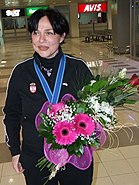
|

|

|

|
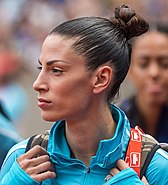
|

|
Historiography
See also
References
- ^Popis 2013(PDF).Sarajevo: BHAS. June 2016. Archived fromthe original(PDF)on 30 June 2016.Retrieved30 June2016.
- ^"Results"(xlsx).Census of Population, Households and Dwellings in 2021.Zagreb:Croatian Bureau of Statistics.2022.Retrieved2 December2022.
- ^"Census of Population, Households and Dwellings in Montenegro 2011"(PDF).12 July 2011.Archived(PDF)from the original on 27 July 2011.Retrieved13 July2011.
- ^abCocozelli, Fred (2016). Ramet, Sabrina (ed.).Ethnic Minorities and Politics in Post-Socialist Southeastern Europe.Cambridge University Press. p. 267.ISBN978-1316982778.Archivedfrom the original on 27 September 2023.Retrieved29 October2020.
- ^"Slovenian census".2011.Archivedfrom the original on 17 November 2014.
- ^Државен завод за статистика."Попис на населението, домаќинствата и становите во Република Македонија, 2002: Дефинитивни податоци"(PDF).Archived(PDF)from the original on 22 September 2010.
- ^"Statistiche demografiche ISTAT"(PDF).Demo.istat.it. Archived fromthe original(PDF)on 1 April 2014.Retrieved3 October2014.
- ^"Дијаспора може да промени Србију".Archivedfrom the original on 14 December 2022.Retrieved28 May2023.
- ^"Innvandring og innvandrere 2006"(PDF).Archived(PDF)from the original on 24 September 2015.
- ^"Tab11. Populaţia stabilă după etnie şi limba maternă, pe categorii de localităţi".Rezultate Definitive_RPL_2011.Institutul Naţional de Statistică. 2011.Archivedfrom the original on 9 November 2013.Retrieved17 April2014.
- ^Vukovich, Gabriella (2018).Mikrocenzus 2016 – 12. Nemzetiségi adatok[2016 microcensus – 12. Ethnic data](PDF)(in Hungarian). Budapest: Hungarian Central Statistical Office.ISBN978-963-235-542-9.Archived(PDF)from the original on 8 August 2019.Retrieved9 January2019.
- ^"SODB2021 - Obyvatelia - Základné výsledky".www.scitanie.sk.Archivedfrom the original on 31 May 2022.Retrieved25 August2022.
- ^"SODB2021 – Obyvatelia – Základné výsledky".www.scitanie.sk.Archivedfrom the original on 15 July 2022.Retrieved25 August2022.
- ^"Srbi u Nemačkoj – Srbi u Njemačkoj – Zentralrat der Serben in Deutschland".zentralrat-der-serben.de.Archived fromthe originalon 8 December 2015.Retrieved26 August2017.
- ^"Migration und Integration"(in German).Archivedfrom the original on 28 May 2018.Retrieved31 May2022.
- ^"Srbi u Austriji traže status nacionalne manjine".Blic.2 October 2010.Archivedfrom the original on 9 January 2015.
- ^"Процењује се да у Француској живи око 200.000 припадника српске дијаспоре, која је настањена у различитим крајевима".20 May 2022.Archivedfrom the original on 7 February 2023.Retrieved6 February2023..
- ^Mediaspora (2002)."Rezultat istrazivanja o broju Srpskih novinara i medija u svetu".Srpska dijaspora. Archived fromthe originalon 27 January 2016.
- ^"saez.ch"(PDF).Archived fromthe original(PDF)on 22 March 2012.
{{cite journal}}:Cite journal requires|journal=(help) - ^Bureau, U.S. Census."American Community Survey 2021".censusreporter.org.Archivedfrom the original on 10 July 2023.Retrieved10 July2023.
- ^"2016 Census of Population".Statistics Canada. 8 February 2017.Archivedfrom the original on 15 November 2021.Retrieved7 October2021.
- ^Stefanovic-Banovic, Milesa; Pantovic, Branislav (2013)."'Our' diaspora in Argentina: Historical overview and preliminary research "(PDF).Glasnik Etnografskog Instituta.61:119–131.doi:10.2298/GEI1301119S.Archived(PDF)from the original on 29 January 2016.Retrieved13 August2020.
На територији Републике Аргентине данас живи око 30 0002људи српског и црногорског порекла, већим делом са простора данашње Црне Горе и Хрватске, а мањим делом из Србије и Босне и Херцеговине.
- ^"Serbs".www.joshuaproject.net.Archivedfrom the original on 18 August 2020.Retrieved13 August2020.
- ^The People of Australia – Statistics from the 2011 Census(PDF).Department of Immigration and Border Protection. 2014. p. 59.ISBN978-1-920996-23-9.Archived fromthe original(PDF)on 14 July 2014.Retrieved16 February2015.
Ancestry
- ^"Srbi u Dubaiju pokrenuli inicijativu za otvaranje konzulata".telegraf.rs.20 April 2012.Archivedfrom the original on 27 August 2017.
- ^"Afrika i Srbija na vezi".RTS, Radio televizija Srbije, Radio Television of Serbia.Archivedfrom the original on 2 April 2015.
- ^Marty, Martin E. (1997).Religion, Ethnicity, and Self-Identity: Nations in Turmoil.University Press of New England.ISBN0-87451-815-6.
[...] the three ethnoreligious groups that have played the roles of the protagonists in the bloody tragedy that has unfolded in the former Yugoslavia: the Christian Orthodox Serbs, the Roman Catholic Croats, and the Muslim Slavs of Bosnia.
- ^"Popis stanovništva, domaćinstava i stanova u Crnoj Gori 2011. godine"(PDF).Archived(PDF)from the original on 9 March 2014.
{{cite journal}}:Cite journal requires|journal=(help) - ^Cirkovic, Sima M. (15 April 2008).The Serbs.John Wiley & Sons.ISBN9781405142915.Archivedfrom the original on 27 September 2023.Retrieved3 October2020.
- ^Djilas, Aleksa (1991).The Contested Country: Yugoslav Unity and Communist Revolution, 1919–1953.Harvard University Press. p.181.ISBN9780674166981.
- ^Byford, Jovan (1 January 2008).Denial and Repression of Antisemitism: Post-communist Remembrance of the Serbian Bishop Nikolaj Velimirovi?.Central European University Press.ISBN9789639776159.Archivedfrom the original on 27 September 2023.Retrieved3 October2020.
- ^Longinović, Toma (12 August 2011).Vampire Nation: Violence as Cultural Imaginary.Duke University Press.ISBN9780822350392.Archivedfrom the original on 27 September 2023.Retrieved3 October2020.
- ^Keil, Soeren (December 2017)."The Serbs in Bosnia and Herzegovina, Croatia, and Kosovo"(PDF).European Review of International Studies.4(2–3).LeidenandBoston:Brill Nijhoff:39–58.doi:10.3224/eris.v4i2-3.03.ISSN2196-7415.JSTOR26593793.Archived(PDF)from the original on 21 July 2018.Retrieved29 May2023.
- ^Khakee, Anna; Florquin, Nicolas (1 June 2003)."Kosovo: Difficult Past, Unclear Future"(PDF).Kosovo and the Gun: A Baseline Assessment of Small Arms and Light Weapons in Kosovo.10.Pristina,United Nations Interim Administration Mission in KosovoandGeneva,Switzerland:Small Arms Survey:4–6.JSTORresrep10739.9.Archived fromthe original(PDF)on 30 June 2022.Retrieved3 March2023.
Kosovo—while still formally part of the so-calledState Union of Serbia and Montenegrodominated bySerbia—has, since the war, been a United Nations protectorate under theUnited Nations Interim Administration Mission in Kosovo(UNMIK). [...] However, members of theKosovo Serbminority of the territory (circa 6–7 per cent in 2000) have, for the most part, not been able to return to their homes. For security reasons, the remainingKosovo Serb enclavesare, in part, isolated from the rest of Kosovo and protected by the multinationalNATO-ledKosovo Force(KFOR).
- ^Буквић, Димитрије."Од златне виљушке до долине јоргована".Politika Online.Archivedfrom the original on 14 July 2022.Retrieved12 July2022.
- ^Ana S. Trbovich (2008).A Legal Geography of Yugoslavia's Disintegration.Oxford University Press, USA. pp. 69–.ISBN978-0-19-533343-5.Archivedfrom the original on 2 January 2016.
- ^Christopher Catherwood (1 January 2002).Why the Nations Rage: Killing in the Name of God.Rowman & Littlefield. pp.135–.ISBN978-0-7425-0090-7.
- ^abEthnologia Balkanica.LIT Verlag Münster. pp. 70–. GGKEY:ES2RY3RRUDS.Archivedfrom the original on 2 January 2016.
- ^abCelia Jaes Falicov (1991).Family Transitions: Continuity and Change Over the Life Cycle.New York City:Guilford Press. p. 219.ISBN978-0-89862-484-7.
- ^Popowska-Taborska, Hanna (1993)."Ślady etnonimów słowiańskich z elementem obcym w nazewnictwie polskim".Acta Universitatis Lodziensis. Folia Linguistica(in Polish).27:225–230.doi:10.18778/0208-6077.27.29.hdl:11089/16320.Archivedfrom the original on 28 October 2020.Retrieved16 August2020.
- ^Popowska-Taborska, Hanna (1999)."Językowe wykładniki opozycji swoi – obcy w procesie tworzenia etnicznej tożsamości".InJerzy Bartmiński(ed.).Językowy obraz świata(in Polish). Lublin: Wydaw. Uniwersytetu Marii Curie-Skłodowskiej. pp. 57–63.Archivedfrom the original on 14 July 2022.Retrieved16 August2020.
- ^Kushniarevich, Alena; et al. (2015)."Genetic Heritage of the Balto-Slavic Speaking Populations: A Synthesis of Autosomal, Mitochondrial and Y-Chromosomal Data".PLOS ONE.10(9): e0135820.Bibcode:2015PLoSO..1035820K.doi:10.1371/journal.pone.0135820.PMC4558026.PMID26332464.
- ^Todorović, I.; Vučetić-Dragović, A.; Marić, A. (2014)."Компаративни аналитички осврт на најновија генетска истраживања порекла Срба и становништва Србије – етнолошка перспектива"(PDF).Glasnik Etnografskog instituta SANU.62(2).doi:10.2298/GEI1402099T.Archived(PDF)from the original on 17 November 2015.
- ^"Y-DNA haplogroups of ethnic Serbs".Порекло(in Serbian). 12 June 2019.Archivedfrom the original on 5 October 2020.Retrieved24 December2019.
- ^Regueiro, Mario; Rivera, Luis; Damnjanovic, Tatjana; Lukovic, Ljiljana; Milasin, Jelena; Herrera, Rene (2012)."High levels of Paleolithic Y-chromosome lineages characterize Serbia".Gene.498(1): 59–67.doi:10.1016/j.gene.2012.01.030.PMID22310393.Archivedfrom the original on 26 May 2021.Retrieved28 August2021.
- ^"Average Height by Country 2022".Archivedfrom the original on 9 July 2021.Retrieved26 November2022.
- ^"Body Height and Its Estimation Utilizing Arm Span Measurements in Serbian Adults"(PDF).Archived(PDF)from the original on 26 March 2017.Retrieved20 March2017.
{{cite journal}}:Cite journal requires|journal=(help) - ^Grasgruber, Pavel; Popović, Stevo; Bokuvka, Dominik; Davidović, Ivan; Hřebíčková, Sylva; Ingrová, Pavlína; Potpara, Predrag; Prce, Stipan; Stračárová, Nikola (2017)."The mountains of giants: An anthropometric survey of male youths in Bosnia and Herzegovina".Royal Society Open Science.4(4): 161054.Bibcode:2017RSOS....461054G.doi:10.1098/rsos.161054.PMC5414258.PMID28484621.
- ^Fine 1991,pp. 26–41.
- ^Fine 1991,p. 29.
- ^Fine 1991,p. 33.
- ^abŽivković 2002,p. 187.
- ^Fine 1991,pp. 38, 41;Ćorović 2001,"Балканска култура у доба сеобе Словена"
- ^Ćirković, Sima M. (2008)."Srbi među europskim narodima (excerpt)"(PDF).www.mo-vrebac-pavlovac.hr.Golden Marketing-Tehnička Knjiga. pp. 26–27.Archived(PDF)from the original on 8 January 2020.Retrieved5 December2019.
- ^Kardaras, Georgios (2018).Byzantium and the Avars, 6th–9th Century AD: Political, Diplomatic and Cultural Relations.BRILL. p. 96.ISBN978-9-00438-226-8.Archivedfrom the original on 27 March 2023.Retrieved13 December2021.
- ^Blagojević 1989,p. 19.
- ^Deliso, Christopher (2008).Culture and Customs of Serbia and Montenegro.ABC-CLIO. p. 13.ISBN978-0-31334-437-4.Archivedfrom the original on 27 September 2023.Retrieved13 December2021.
- ^Morozova, Maria (2019)."Language Contact in Social Context: Kinship Terms and Kinship Relations of the Mrkovići in Southern Montenegro".Journal of Language Contact.12(2): 307.doi:10.1163/19552629-01202003.Retrieved15 February2020.
- ^Komatina 2014,p. 38.
- ^Fine 1991,p. 160,202,225.
- ^Miller 2005,p. 533.
- ^abcCox 2002,p. 20.
- ^Vance, Charles; Paik, Yongsun (2006).Managing a Global Workforce: Challenges and Opportunities in International Human Resource Management.M.E. Sharpe. p. 379.ISBN978-0-76562-016-3.Archivedfrom the original on 27 March 2023.Retrieved13 December2021.
- ^Cox 2002,p. 21.
- ^abcdCox 2002,pp. 23–24.
- ^abcdeĆirković 2004.
- ^Rajko L. Veselinović (1966).(1219–1766). Udžbenik za IV razred srpskih pravoslavnih bogoslovija. (Yu 68-1914).Sv. Arh. Sinod Srpske pravoslavne crkve. pp. 70–71.
Устанак Срба у Банату и спалмваъье моштийу св. Саве 1594. — Почетком 1594. године Срби у Банату почели су нападати Турке. Устанак се -нарочито почео ширити после освадаъьа и спашьиваъьа Вршца од стране чете -Петра Маджадца. Устаници осводе неколико утврЬених градова (Охат [...]
- ^Editions speciales.Naučno delo. 1971.Archivedfrom the original on 27 September 2023.Retrieved8 July2019.
Дошло ]е до похреаа Срба у Ба- нату, ко]и су помагали тадаппьи црногоски владика, Херувим и тре- бюьски, Висарион. До покрета и борбе против Ту рака дошло ]е 1596. године и у Цр- иэ] Гори и сус]едним племенима у Харцеговгаш, нарочито под утица- ]ем поменутог владике Висариона. Идупе, 1597. године, [...] Али, а\адика Висарион и во]вода Грдан радили су и дал>е на организован>у борбе, па су придобили и...
- ^abFotić 2008a,p. 517–519.
- ^Gavrilović, Slavko (2006),"Isaija Đaković"(PDF),Zbornik Matice Srpske za Istoriju(in Serbian), vol. 74, Novi Sad:Matica Srpska,Department of Social Sciences, Proceedings i History, p. 7, archived fromthe original(PDF)on 16 September 2011,retrieved21 December2011
- ^Janićijević, Jovan (1996),Kulturna riznica Srbije(in Serbian), IDEA, p. 70,ISBN9788675470397,archivedfrom the original on 2 January 2016,
Велики или Бечки рат Аустрије против Турске, у којем су Срби, као добровољци, масовно учествовали на аустријској страни
- ^A ́goston & Masters 2010,p. 383.
- ^Riley-Smith 2001,p. 251.
- ^Rodriguez 1997,p. 6.
- ^Kia 2011,p. 62.
- ^abJelavich 1983,p. 145.
- ^"Stopama Isakoviča, Karađorđa i komunista – Seobe u Rusiju – Nedeljnik Vreme".www.vreme.com(in Serbian). 23 November 2011.Archivedfrom the original on 14 July 2022.Retrieved12 July2022.
- ^"Сеоба Срба у Русију – отишли да их нема".Politika Online.Archivedfrom the original on 14 July 2022.Retrieved12 July2022.
- ^"[Projekat Rastko] Ljubivoje Cerovic: Srbi u Ukrajini".www.rastko.rs.Archivedfrom the original on 7 June 2023.Retrieved12 July2022.
- ^Mitev, Plamen (2010).Empires and Peninsulas: Southeastern Europe Between Karlowitz and the Peace of Adrianople, 1699-1829.LIT Verlag Münster. p. 144.ISBN978-3643106117.Archivedfrom the original on 27 September 2023.Retrieved3 October2020.
- ^MacKenzie, David (1988). "Reviewed work: Knezevina Srbija (1830–1839)., Rados Ljusic".Slavic Review.47(2): 362–363.doi:10.2307/2498513.JSTOR2498513.S2CID164191946.
- ^Misha Glenny."The Balkans Nationalism, War and the Great Powers, 1804–1999".The New York Times.Archivedfrom the original on 15 April 2009.Retrieved6 April2010.
- ^Royal Family."200 godina ustanka".Royalfamily.org. Archived fromthe originalon 7 February 2010.Retrieved28 April2010.
- ^Gordana Stokić (January 2003)."Bibliotekarstvo i menadžment: Moguća paralela"(PDF)(in Serbian). Narodna biblioteka Srbije.Archivedfrom the original on 7 March 2016.
- ^Mojović, Dragan (2007). "Velike Srbije nikada nije bilo".NIN:82, 83.
- ^Avramović, Sima (2014)."Srpski građanski zakonik (1844) i pravni transplanti – kopija austrijskog uzora ili više od toga?"(PDF).Srpski Građanski Zakonik – 170 Godina.Archived fromthe original(PDF)on 25 July 2020.Retrieved1 August2019.
- ^Miller 2005,p. 542.
- ^Pavlowitch 2002,p. 94.
- ^Miller 2005,pp. 542–543.
- ^Radivojević, Biljana; Penev, Goran (2014)."Demographic losses of Serbia in the first world war and their long-term consequences".Economic Annals.59(203): 29–54.doi:10.2298/EKA1403029R.
- ^Miller 2005,p. 544.
- ^abMiller 2005,p. 545.
- ^Yeomans 2015,p. 18.
- ^abLevy 2009.
- ^"Ustasa"(PDF).Yad Vashem.Archived(PDF)from the original on 8 August 2019.Retrieved25 June2018.
- ^"Croatia: Serbs".Minority Rights Group International.19 June 2015.Archivedfrom the original on 2 October 2015.Retrieved28 July2019.
- ^Yeomans 2013,p. 7.
- ^Kallis 2008,pp. 130–131.
- ^Bartulin 2013,p. 124.
- ^"SISAK CAMP".Jasenovac Memorial Cite.Archived fromthe originalon 31 January 2018.Retrieved30 January2018.
- ^Marija Vuselica: Regionen Kroatien in Der Ort des Terrors: Arbeitserziehungslager, Ghettos, Jugendschutzlager, Polizeihaftlager, Sonderlager, Zigeunerlager, Zwangsarbeiterlager, Volume 9 of Der Ort des Terrors, Publisher C.H.Beck, 2009,ISBN9783406572388pages 321–323
- ^Anna Maria Grünfelder: Arbeitseinsatz für die Neuordnung Europas: Zivil- und ZwangsarbeiterInnen aus Jugoslawien in der "Ostmark" 1938/41-1945, Publisher Böhlau Verlag Wien, 2010ISBN9783205784531pages 101–106
- ^Charny 1999,pp. 18–23.
- ^Payne 2006,pp. 18–23.
- ^Dulić 2006.
- ^Kolanović, Josip, ed. (2003).Dnevnik Diane Budisavljević 1941–1945.Zagreb:Croatian State Archivesand Public InstitutionJasenovac Memorial Area.pp. 284–85.ISBN978-9-536-00562-8.
- ^Lomović, Boško (2014).Die Heldin aus Innsbruck – Diana Obexer Budisavljević.Belgrade: Svet knjige. p. 28.ISBN978-86-7396-487-4.Archived fromthe originalon 1 April 2016.Retrieved28 July2019.
- ^Hoare 2011,p. 207.
- ^Calic 2019,p. 463.
- ^Marko Attila Hoare."The Great Serbian threat, ZAVNOBiH and Muslim Bosniak entry into the People's Liberation Movement"(PDF).anubih.ba.Posebna izdanja ANUBiH. p. 123. Archived fromthe original(PDF)on 1 February 2021.Retrieved21 December2020.
- ^Miller 2005,pp. 546–553.
- ^Miller 2005,pp. 558–562.
- ^Gall, Carlotta (7 May 2000)."New Support to Help Serbs Return to Homes in Kosovo".The New York Times.Archivedfrom the original on 3 February 2017.Retrieved20 February2017.
- ^Pavlowitch 2002,p. 225.
- ^Djordjević & Zaimi 2019,p. 53-69.
- ^"Biz – Vesti – Srbi za poslom idu i na kraj sveta".B92. 30 April 2012.Archivedfrom the original on 13 December 2014.Retrieved17 April2014.
- ^""Европски Љубичевац": Гастарбајтерско село у којем има свега, само нема људи ".BBC News на српском(in Serbian (Cyrillic script)). 16 June 2022.Archivedfrom the original on 14 July 2022.Retrieved12 July2022.
- ^"Serbia seeks to fill the '90s brain-drainage gap".EMG.rs. 5 September 2008.Archivedfrom the original on 29 May 2012.
- ^"Survey S&M 1/2003".Yugoslav Survey.Archivedfrom the original on 11 January 2013.Retrieved13 December2013.
- ^Benjamin W. Fortson, IV (7 September 2011).Indo-European Language and Culture: An Introduction.John Wiley & Sons. p. 431.ISBN978-1-4443-5968-8.Archivedfrom the original on 2 January 2016.
- ^Magner, Thomas F. (10 January 2001)."Digraphia in the territories of the Croats and Serbs".International Journal of the Sociology of Language.2001(150).doi:10.1515/ijsl.2001.028.Archivedfrom the original on 11 October 2017.Retrieved27 April2018.
- ^Dejan Ivković (2013). "Pragmatics meets ideology: Digraphia and non-standard orthographic practices in Serbian online news forums".Journal of Language and Politics.12(3).John Benjamins Publishing Company.doi:10.1075/jlp.12.3.02ivk.
- ^Mojca Ramšak (2008). "Karadžić, Vuk Stefanović (1787–1864)". In Donald Haase (ed.).The Greenwood Encyclopedia of Folktales and Fairy Tales: G-P.Westport, Connecticut:Greenwood Publishing Group.p.531.ISBN978-0-313-33443-6.Archivedfrom the original on 3 February 2017.
- ^Comrie, Bernard;Corbett, Greville G. (1 September 2003).The Slavonic Languages.Taylor & Francis. p. 45.ISBN978-0-203-21320-9.Archivedfrom the original on 27 September 2023.Retrieved23 December2013.
... following Vuk's reform of Cyrillic (see above) in the early nineteenth century, Ljudevit Gaj in the 1830s performed the same operation on Latinica,...
- ^Јасна Влајић-Поповић,„Грецизми у српском језику: осврт на досадашња и поглед на будућа истраживања “Archived11 March 2020 at theWayback Machine,Јужнословенски филолог,књ. 65 (2009), Београд, стр. 375–403
- ^abЛексикон страних речи и израза / Милан Вујаклија, Просвета, Београд (1954)(in Serbian)
- ^Dejan J. Ivović (2013)."ITALIJANIZMI U GOVORNOM JEZIKU"(PDF).Archived(PDF)from the original on 24 October 2019.Retrieved23 July2019.
- ^abcdNomachi 2015,p. 48.
- ^Nomachi 2015,pp. 48–49.
- ^Nomachi 2015,p. 49.
- ^"Deutsches Wörterbuch von Jacob Grimm und Wilhelm Grimm. 16 Bde. (in 32 Teilbänden). Leipzig: S. Hirzel 1854–1960"(in German). Archived fromthe originalon 26 September 2007.Retrieved13 June2006.
- ^"Vampire".Merriam-Webster Online Dictionary. Archived fromthe originalon 14 June 2006.Retrieved13 June2006.
- ^"Trésor de la Langue Française informatisé"(in French).Archivedfrom the original on 30 December 2017.Retrieved13 June2006.
- ^Dauzat, Albert (1938).Dictionnaire étymologique de la langue française(in French). Paris: Librairie Larousse.OCLC904687.
- ^Димитрије Оболенски„Византијски комонвелт “,Београд. 1991
- ^Kadijević, Aleksandar Đ. (2017). "About typology and meaning of the Serbian public architectural monuments (19–20th centuries)".Matica Srpska Journal for Fine Arts.45.
- ^Cox 2002,pp. 11–12.
- ^Žunjić, Slobodan (2010).Istorija srpske filozofije.Belgrade: Plato.ISBN9788644704829.
- ^abCox 2002,p. 12.
- ^Milošević, Ana."OLD ICON PAINTING AND THE RELIGIOUS REVIVAL IN THE 'KINGDOM OF SERBIA' DURING AUSTRIAN RULE 1718–1739".Byzantine Heritage and Serbian Art III Imagining the Past the Reception of the Middle Ages in Serbian Art from the 18 Th to the 21 St Century.Archivedfrom the original on 23 March 2023.Retrieved26 September2019.
- ^"Projekat Rastko: Istorija srpske kulture".rastko.rs.Archivedfrom the original on 8 March 2021.Retrieved26 July2019.
- ^"18. vek".Nedeljnik Vreme.16 October 2013.Archivedfrom the original on 19 February 2020.Retrieved26 July2019.
- ^"Biedermeier Of The 19th Century".galerijamaticesrpske.rs.Archived fromthe originalon 10 January 2019.Retrieved28 April2019.
- ^"19. vek".Nedeljnik Vreme.16 October 2013.Archivedfrom the original on 2 March 2020.Retrieved28 April2019.
- ^Mitchell, Laurence (2010).Serbia.Bradt Travel Guides. p. 43.ISBN978-1-84162-326-9.Archivedfrom the original on 27 September 2023.Retrieved1 August2019.
- ^"Romanticism Of The 19th Century".galerijamaticesrpske.rs.Archived fromthe originalon 4 April 2017.Retrieved10 June2019.
- ^Cox 2002,p. 121.
- ^"Marina Abramovic in Belgrade: A long-awaited homecoming | DW | 19.09.2019".DW.COM.Archivedfrom the original on 14 July 2022.Retrieved12 July2022.
- ^Đorđević, Oliver, ed. (2016).Living tradition: guide to roots and folk music in Serbia.Belgrade: World music association of Serbia. pp. 9–15.ISBN978-86-89607-20-8.
- ^"[Project Rastko] THE HISTORY OF SERBIAN CULTURE – Roksanda Pejovic: Medieval music".www.rastko.rs.Archivedfrom the original on 25 February 2022.Retrieved12 July2022.
- ^"Projekat Rastko: Istorija srpske kulture".Rastko.rs.Archivedfrom the original on 3 June 2012.Retrieved24 May2012.
- ^"Stevan Stojanović Mokranjac (1856—1914)".Riznicasrpska.net. 28 September 1914.Archivedfrom the original on 26 September 2013.Retrieved24 May2012.
- ^"Ljubica Marić | Udruženje kompozitora Srbije".composers.rs.Archivedfrom the original on 14 July 2022.Retrieved12 July2022.
- ^Bills, John William (15 December 2017)."The 10 Best Classical Composers From Serbia".Culture Trip.Archivedfrom the original on 25 February 2021.Retrieved10 July2019.
- ^Cox 2002,p. 13.
- ^Richard Taylor, Nancy Wood, Julian Graffy, Dina Iordanova (2019).The BFI Companion to Eastern European and Russian Cinema.Bloomsbury. p. 1936.ISBN978-1838718497.
{{cite book}}:CS1 maint: multiple names: authors list (link) - ^"Emir Kusturica".UNICEF Serbia.Archivedfrom the original on 12 August 2014.
- ^"Карл Малден – дискретни холивудски херој српског порекла".BBC News на српском(in Serbian (Cyrillic script)). 22 March 2022.Archivedfrom the original on 14 July 2022.Retrieved12 July2022.
- ^"Најпоштованији Србин у Холивуду".Politika Online.Archivedfrom the original on 14 July 2022.Retrieved12 July2022.
- ^"Osam vekova srpske književnosti".www2.filg.uj.edu.pl.Archivedfrom the original on 14 July 2022.Retrieved12 July2022.
- ^Deretić, Jovan (2011).Istorija srpske kulture.Belgrade: Evro-Giunti. pp. 153, 155.ISBN978-86-505-1849-6.
- ^abMiller 2005,pp. 565–567.
- ^abBédé & Edgerton 1980,p. 734.
- ^Miller 2005,pp. –565–567.
- ^Sollars & Jennings 2008,p. 604.
- ^"Serbian roots, American spirit: An interview with Charles Simic".Balkan Insight.25 May 2011.Archivedfrom the original on 2 August 2019.Retrieved2 August2019.
- ^Sinhro.rs (11 July 2016)."ZORAN ŽIVKOVIĆ: Zašto da pišem o naučnoj fantastici, kad u njoj živimo » Sinhro.rs".Sinhro.rs.Archivedfrom the original on 14 July 2022.Retrieved12 July2022.
- ^Preradović, Zoran (14 December 2007)."Srpski pisac sa najviše prevoda".Radio Slobodna Evropa(in Serbo-Croatian).Archivedfrom the original on 14 July 2022.Retrieved12 July2022.
- ^"Ko su danas najveći srpski naučnici".Nedeljnik.Archived fromthe originalon 23 March 2023.Retrieved12 July2022.
- ^"Serbs of the Apollo Space Program Honored | Serbian Orthodox Church [Official web site]".www.spc.rs.Archived fromthe originalon 8 July 2019.Retrieved2 August2019.
- ^Vladimir."The Meaning of Reality".Serbica Americana.Archivedfrom the original on 24 July 2019.Retrieved2 August2019.
- ^"Great Serbian scientists".Consulate General of the Republic of Serbia. Archived fromthe originalon 12 June 2008.
- ^"Gordana Vunjak-Novakovic – Google Scholar Citations".Google Scholar.Archivedfrom the original on 1 January 2020.Retrieved31 March2018.
- ^"People « National Tourism Organisation of Serbia".serbia.travel. Archived fromthe originalon 23 December 2014.Retrieved12 January2015.
- ^Jandric, Miroslav (2011).Three Centuries from the Birth of Rudjer Boskovic (1711– 1787)(PDF).pp. 449 (footnote).Archived(PDF)from the original on 22 December 2018.Retrieved31 March2018.
- ^"Boris Tadić: Ruđer Bošković je bio Srbin katolik. Nadam se da me Hrvati neće krivo shvatiti – Jutarnji List".jutarnji.hr.13 January 2012.Archivedfrom the original on 1 April 2018.Retrieved31 March2018.
- ^Georgevich, Dragoslav (1977).Serbian Americans and their communities in Cleveland.p. 73.Archivedfrom the original on 27 September 2023.Retrieved3 October2020.
- ^Lubarda, Biljana."Plant species and subspecies discovered by Dr. Josif Pančić 1 – distribution and floristic importance".Archivedfrom the original on 8 March 2022.Retrieved27 December2019.
{{cite journal}}:Cite journal requires|journal=(help) - ^General Encyclopedia of the Yugoslav Lexicographical Institute, III edition, Vol 2 C-Fob.Jugoslavenski leksikografski zavod "Miroslav Krleža".1977.
- ^"Short biography".Archivedfrom the original on 12 February 2018.Retrieved31 March2018.
- ^"O poreklu obožavanja i straha od VUKA: Prema predanju on je mitološki predstavnik srpskog naroda".National Geographic(in Serbian).Archivedfrom the original on 14 July 2022.Retrieved12 July2022.
- ^Loma, Aleksandar (2021). "Srbi i vuci u istraživanjima Veselina Čajkanovića".Književna istorija.174:13–44.
- ^Tanjug."Srbija, zemlja Milice i Dragana: Društvo: POLITIKA".Politika.Archivedfrom the original on 16 June 2014.Retrieved17 April2014.
- ^Fotić 2008b,p. 519–520.
- ^"О НАМА | Православна Црква у Чилеу".www.pravoslavie.cl.7 September 2016.Archivedfrom the original on 24 February 2020.Retrieved8 February2020.
- ^Cvetković 2012,p. 130.
- ^Grumeza, Ion (2010).The Roots of Balkanization Eastern Europe C.E. 500-1500.United States of America: University Press of America. p. 161.ISBN978-0-7618-5135-6.
- ^World and Its Peoples.Marshall Cavendish. 2010.ISBN9780761479031.Archivedfrom the original on 27 September 2023.Retrieved3 October2020.
- ^Bjelajac, Branko (2002)."Protestantism in Serbia".Religion, State and Society.30(3): 169–218.doi:10.1080/0963749022000009225.ISSN0963-7494.S2CID144017406.Archivedfrom the original on 23 March 2023.Retrieved26 September2019.
- ^"Nisu svi Srbi pravoslavne vere".Politika.Archivedfrom the original on 10 September 2019.Retrieved26 September2019.
- ^Christian Promitzer; Klaus-Jürgen Hermanik & Eduard Staudinger (2009).(Hidden) Minorities: Language and Ethnic Identity Between Central Europe and the Balkans.The Lit Verlag in 2009.ISBN9783643500960.Archivedfrom the original on 2 January 2016.Retrieved5 February2013.
- ^Bozic, Sofija (1 January 2014)."Umetnost, politika, svakodnevica – tematski okviri prijateljstva Marka Murata i Milana Sevica".Prilozi za književnost, jezik, istoriju i folklor(80): 203–217.doi:10.2298/PKJIF1480203B.
...Ove tvoje poslednje reklo bi se da nisi primio moju gde sam Ti doneo jednu istinitu priču o Zmaju kad ono bijaše u Dubr. o otkrivanju spomenika Dživu Gunduliću. Pitao Zmaj jednog mladog dubrovačkog majstora da mu pokaže gde je srpska crkva. Mladić odgovori: "Koja?" Zmaj: "Srpska". Mladić: "Koja? Ovdi su u nas sve srpske. Koju mislite?" Zmaj: "Pravoslavnu". Mladić: "E! tako recite. Pravoslavna vam je она онамо". I Zmaj je pohvalio našega meštra koji mu je dao dobru lekciju. — Ali sve zaludu, Milane moj! Ovi naši pravoslavci (koji ne vjeruju ništa, ateiste) zbog vere ne priznaju nas. Nismo im pravi. Ne veruju nikome. Ni vama šojkama. Valjda im niste dovoljno pravoslavni!! Jer su oni jako skrupolozni in re fidei et morum. Et morum, Milane moj! E se non ridi — piange piuttosto. Zato nam ide sve ovako manjifiko. Hoćemo mi našu specijalnu kulturu! Sve su drugo švabe kelerabe etcetc!
- ^Mirjana Prošić-Dvornić (1989).Narodna nošnja Šumadije.Kulturno-Prosvjetni Sabor Hrvatske. p. 62.ISBN9788680825526.Archivedfrom the original on 2 January 2016.
- ^abDragoljub Zamurović; Ilja Slani; Madge Phillips-Tomašević (2002).Serbia: life and customs.ULUPUDS. p. 194.ISBN9788682893059.Archivedfrom the original on 2 January 2016.
- ^Deliso, Christopher (2009).Culture and Customs of Serbia and Montenegro.Westport, Connecticut:Greenwood Publishing Group. p.97.ISBN978-0-313-34436-7.
- ^Resić, Sanimir; Plewa, Barbara Törnquist (2002).The Balkans in Focus: Cultural Boundaries in Europe.Lund, Sweden:Nordic Academic Press. p. 48.ISBN978-91-89116-38-2.Archivedfrom the original on 2 January 2016.
- ^"Riznica – Čuvari Hristovog groba".www.rts.rs.RTS, Radio televizija Srbije, Radio Television of Serbia.Archivedfrom the original on 15 December 2019.Retrieved13 January2021.
- ^abcdAlbala 2011,pp. 328–330.
- ^"Живот између повојнице и поскурица:" Прича о хлебу је прича о нама самима "".BBC News на српском(in Serbian (Cyrillic script)). 9 March 2020.Archivedfrom the original on 14 July 2022.Retrieved12 July2022.
- ^Haraksimová, Erna; Rita Mokrá; Dagmar Smrčinová (2006). "slivovica".Anglicko-slovenský a slovensko-anglický slovník.Praha: Ottovo nakladatelství. p. 775.ISBN80-7360-457-4.
- ^abcdStephen Mennell (2005).Culinary Cultures of Europe: Identity, Diversity and Dialogue.Council of Europe. p. 383.ISBN978-92-871-5744-7.Archivedfrom the original on 23 June 2013.
- ^Grolier Incorporated (2000).The encyclopedia Americana.Grolier. p.715.ISBN978-0-7172-0133-4.
- ^"Preliminary 2011 Data".FAOSTAT.Archivedfrom the original on 6 September 2015.
- ^"Fruit Industry in Serbia"(PDF).SIEPA.Archived(PDF)from the original on 11 May 2011.
- ^Štetić, Marina N. (2020).Vinogradarstvo u srednjovekovnoj Srbiji.Belgrade: University of Belgrade, Faculty of philosophy. p. 25.
- ^"Od cara Marka Aurelija Proba do kneza Mihaila Obrenovića: Istorija vinogradarstva i vinskog turizma u Srbiji".National Geographic(in Serbian).Archivedfrom the original on 14 July 2022.Retrieved12 July2022.
- ^"Momčilo Tapavica je bio arhitekta i PRVI SLOVEN koji je osvojio olimpijsku medalje, NjEGOVIM ZGRADAMA divio se i kralj Nikola".Večernje novosti(in Serbian).Archivedfrom the original on 22 July 2020.Retrieved22 July2020.
- ^"10 naših olimpijskih heroja".Nedeljnik.Archived fromthe originalon 23 March 2023.Retrieved22 July2020.
- ^"Hall of Fame nominee: Nemanja Vidic".www.premierleague.com.Archivedfrom the original on 23 June 2021.Retrieved21 June2021.
- ^Shivam Kumar (27 January 2010)."Serbia's Endless List of Wonderkids".Sportslens.Archivedfrom the original on 3 December 2013.Retrieved12 December2013.
- ^"Srbija šesta na listi najvećih izvoznika fudbalera na svetu – Sport – Dnevni list Danas"(in Serbian). 16 May 2020.Archivedfrom the original on 14 July 2022.Retrieved12 July2022.
- ^"Kings General Manager Vlade Divac Elected Into Naismith Memorial Basketball Hall of Fame".Sacramento Kings.Archivedfrom the original on 24 June 2021.Retrieved19 June2021.
- ^"Nikola Jokic wins 2020–21 Kia NBA Most Valuable Player Award".www.nba.com.Archivedfrom the original on 21 July 2021.Retrieved9 June2021.
- ^"Nikola Jokic Named 2023 NBA Finals MVP After Record-Shattering Postseason Leads Nuggets to First Title".13 June 2023.
- ^"2014–15 bwin MVP: Nemanja Bjelica, Fenerbahce Ulker Istanbul".Welcome to EUROLEAGUE BASKETBALL.Archivedfrom the original on 27 September 2023.Retrieved18 June2021.
- ^"Efes's Vasilije Micic is voted the EuroLeague's 2020–21 season MVP!".Welcome to EUROLEAGUE BASKETBALL.Archivedfrom the original on 27 September 2023.Retrieved18 June2021.
- ^"Secrets of the Serbian coaching school".Welcome to EUROLEAGUE BASKETBALL.26 May 2023.Archivedfrom the original on 27 September 2023.Retrieved14 May2021.
- ^"DJOKOVIC CLINCHES RECORD-EXTENDING EIGHTH YEAR-END NO. 1".
- ^"Novak Djokovic Put the Men's Tennis GOAT Debate to Rest in 2023".26 December 2023.
- ^"Nenad Zimonjic".ATP World Tour.Archivedfrom the original on 12 April 2022.Retrieved14 April2022.
- ^"Jankovic to take number one spot".BBC Sport.2 August 2008.Archivedfrom the original on 30 December 2018.Retrieved14 April2022.
- ^"Ana Ivanovic".WTA.14 April 2022.Archivedfrom the original on 11 April 2022.Retrieved14 April2022.
- ^"Vaterpolo Srbija – Serbia Water Polo: Velika imena".www.waterpoloserbia.org.Archivedfrom the original on 14 July 2022.Retrieved12 July2022.
- ^Војводине, Јавна медијска установа ЈМУ Радио-телевизија."Svetlana Kitić najbolja rukometašica sveta svih vremena".ЈМУ Радио-телевизија Војводине.Archivedfrom the original on 14 July 2022.Retrieved12 July2022.
- ^"Neprevaziđena Jasna Šekarić i pet olimpijskih medalja!".Sportklub(in Serbian). 6 August 2021.Archivedfrom the original on 14 July 2022.Retrieved12 July2022.
- ^"Srpski džudista Nemanja Majdov prvak sveta".NOVOSTI.Archivedfrom the original on 4 February 2021.Retrieved5 August2020.
- ^"Olympics-Taekwondo-Serbia's Mandic wins women's +67kg gold medal".reuters.com.14 April 2022.Archivedfrom the original on 27 July 2021.Retrieved27 July2021.
- ^"ISTRAŽIVANJE: Najbolji severnoamerički sportisti srpskog porekla".mozzartsport.com.Archivedfrom the original on 27 July 2019.Retrieved27 July2019.
Sources
Primary sources
- Кунчер, Драгана (2009).Gesta Regum Sclavorum.Vol. 1. Београд-Никшић: Историјски институт, Манастир Острог.Archivedfrom the original on 10 August 2020.Retrieved20 May2019.
- Moravcsik, Gyula,ed. (1967) [1949].Constantine Porphyrogenitus: De Administrando Imperio(2nd revised ed.). Washington D.C.: Dumbarton Oaks Center for Byzantine Studies.ISBN9780884020219.Archivedfrom the original on 20 January 2023.Retrieved7 March2018.
- Pertz, Georg Heinrich,ed. (1845).Einhardi Annales.Hanover.Archivedfrom the original on 27 September 2023.Retrieved20 May2019.
- Constantine VIIPorphyrogenitus(1840).De Ceremoniis(Reiske, J. J. ed.). Impensis E. Weberi.
- Scholz, Bernhard Walter, ed. (1970).Carolingian Chronicles: Royal Frankish Annals and Nithard's Histories.University of Michigan Press.ISBN0472061860.Archivedfrom the original on 27 September 2023.Retrieved20 May2019.
- Шишић, Фердо,ed. (1928).Летопис Попа Дукљанина (Chronicle of the Priest of Duklja).Београд-Загреб: Српска краљевска академија.
- Thurn, Hans, ed. (1973).Ioannis Scylitzae Synopsis historiarum.Berlin-New York: De Gruyter.ISBN9783110022858.Archivedfrom the original on 27 September 2023.Retrieved20 May2019.
- Живковић, Тибор(2009).Gesta Regum Sclavorum.Vol. 2. Београд-Никшић: Историјски институт, Манастир Острог.Archivedfrom the original on 1 May 2019.Retrieved20 May2019.
Secondary sources
- Albala, Ken (2011).Food Cultures of the World Encyclopedia.Santa Barbara, California: ABC-CLIO.ISBN978-0-313-37626-9.Archivedfrom the original on 27 September 2023.Retrieved3 October2020.
- Bataković, Dušan T.(1996).The Serbs of Bosnia & Herzegovina: History and Politics.Paris: Dialogue.ISBN9782911527104.Archivedfrom the original on 15 January 2023.Retrieved10 May2019.
- Bataković, Dušan T.,ed. (2005).Histoire du peuple serbe[History of the Serbian People] (in French). Lausanne: L'Age d'Homme.ISBN9782825119587.Archivedfrom the original on 23 January 2023.Retrieved10 May2019.
- Bédé, Jean Albert; Edgerton, William Benbow (1980).The Columbia Dictionary of Modern European Literature.New York, NY: Columbia University Press.ISBN978-0-231-03717-4.Archivedfrom the original on 27 September 2023.Retrieved3 October2020.
- Ćirković, Sima(2004).The Serbs.Malden: Blackwell Publishing.ISBN9781405142915.
- Calic, Marie–Janine (2019).The Great Cauldron: A History of Southeastern Europe.Cambridge, Massachusetts: Harvard University Press.ISBN978-0-67498-392-2.Archivedfrom the original on 27 September 2023.Retrieved22 January2020.
- Ćorović, Vladimir(2001) [1997]."Српски покрет 1848. године".Историја српског народа(in Serbian). Belgrade: Јанус.Archivedfrom the original on 6 June 2019.Retrieved1 October2023.
- Cox, John K. (2002).The History of Serbia.Westport, Connecticut: Greenwood Press.ISBN9780313312908.
- Curta, Florin(2001).The Making of the Slavs: History and Archaeology of the Lower Danube Region, c. 500–700.Cambridge: Cambridge University Press.ISBN9781139428880.Archivedfrom the original on 27 September 2023.Retrieved20 May2019.
- Curta, Florin(2006).Southeastern Europe in the Middle Ages, 500–1250.Cambridge: Cambridge University Press.
- Cvetković, Vladimir (2012). Casiday, Augustine (ed.).The Orthodox Christian World.London: Routledge.ISBN978-1-136-31484-1.Archivedfrom the original on 27 September 2023.Retrieved3 October2020.
- Djordjević, Ljubica; Zaimi, Zenajda (2019)."Commentary: The Law on Protection of National Minorities in the Republic of Albania"(PDF).Journal on Ethnopolitics and Minority Issues in Europe.18(1): 53–69.Archived(PDF)from the original on 14 July 2020.Retrieved28 October2020.
- Fine, John Van Antwerp Jr.(1991) [1983].The Early Medieval Balkans: A Critical Survey from the Sixth to the Late Twelfth Century.Ann Arbor, Michigan: University of Michigan Press.ISBN0472081497.Archivedfrom the original on 15 January 2023.Retrieved20 May2019.
- Fine, John Van Antwerp Jr.(1994) [1987].The Late Medieval Balkans: A Critical Survey from the Late Twelfth Century to the Ottoman Conquest.Ann Arbor, Michigan: University of Michigan Press.ISBN0472082604.Archivedfrom the original on 15 January 2023.Retrieved20 May2019.
- Fotić, Aleksandar (2008a). "Serbia".Encyclopedia of the Ottoman Empire.New York: Infobase Publishing. pp. 517–519.ISBN9781438110257.Archivedfrom the original on 14 January 2023.Retrieved25 October2015.
- Fotić, Aleksandar (2008b). "Serbian Orthodox Church".Encyclopedia of the Ottoman Empire.New York: Infobase Publishing. pp. 519–520.ISBN9781438110257.Archivedfrom the original on 14 January 2023.Retrieved25 October2015.
- Hoare, Marko Attila(2011). "The Partisans and the Serbs". In Ramet, Sabrina P.; Listhaug, Ola (eds.).Serbia and the Serbs in World War Two.London, England: Palgrave Macmillan. pp. 201–224.ISBN978-0-23034-781-6.
- Halpern, Joel Martin (1956).Social and Cultural Change in a Serbian Village.Columbia University.
- Ivić, Pavle,ed. (1995).The History of Serbian Culture.Edgware: Porthill Publishers.ISBN9781870732314.Archivedfrom the original on 27 September 2023.Retrieved7 March2018.
- Jelavich, Barbara(1983a).History of the Balkans: Eighteenth and Nineteenth Centuries.Vol. 1. Cambridge University Press.ISBN9780521252492.Archivedfrom the original on 23 January 2023.Retrieved7 March2018.
- Jelavich, Barbara(1983b).History of the Balkans: Twentieth Century.Vol. 2. Cambridge University Press.ISBN9780521274593.
- Judah, Tim(2000).The Serbs: History, Myth and the Destruction of Yugoslavia.New Haven: Yale University Press.ISBN978-0-300-08507-5.Archivedfrom the original on 27 September 2023.Retrieved25 October2015.
- Judah, Tim (2002).Kosovo: War and Revenge.New Haven: Yale University Press.ISBN978-0-300-09725-2.Archivedfrom the original on 11 January 2023.Retrieved25 October2015.
- Katić, Tatjana (2012).Tursko osvajanje Srbije 1690. godine.Beograd: Srpski genealoški centar, Centar za osmanističke studije.Archivedfrom the original on 5 April 2023.Retrieved10 May2019.
- Komatina, Predrag (2014)."Settlement of the Slavs in Asia Minor During the Rule of Justinian II and the Bishopric των Γορδοσερβων"(PDF).Београдски историјски гласник: Belgrade Historical Review.5:33–42.Archived(PDF)from the original on 4 February 2022.Retrieved4 February2022.
- Miller, Nicholas J. (1997).Between Nation and State: Serbian Politics in Croatia Before the First World War.Pittsburgh: University of Pittsburgh Press.ISBN9780822939894.
- Miller, Nicholas J. (2005). "Serbia and Montenegro".Eastern Europe: An Introduction to the People, Lands, and Culture.Vol. 3. Santa Barbara, California: ABC-CLIO. pp. 529–581.ISBN9781576078006.Archivedfrom the original on 21 January 2023.Retrieved25 October2015.
- Nomachi, Motoki (2015).""East" and "West" as Seen in the Structure of Serbian: Language Contact and Its Consequences "(PDF).Slavic Eurasian Studies.28.Archived(PDF)from the original on 5 October 2023.Retrieved1 October2023.
- Pavlowitch, Stevan K.(2002).Serbia: The History behind the Name.London: Hurst & Company.ISBN9781850654773.Archivedfrom the original on 23 January 2023.Retrieved7 March2018.
- Pavlowitch, Stevan K.(2008).Hitler's new disorder: The Second World War in Yugoslavia.New York: Columbia University Press.ISBN9780231700504.Archivedfrom the original on 20 July 2023.Retrieved7 March2018.
- Sollars, Michael David; Jennings, Arbolina Llamas (2008).The Facts on File Companion to the World Novel: 1900 to the Present.New York, NY: Infobase Publishing.ISBN978-1-4381-0836-0.Archivedfrom the original on 27 September 2023.Retrieved3 October2020.
- Živković, Tibor;Bojanin, Stanoje; Petrović, Vladeta, eds. (2000).Selected Charters of Serbian Rulers (XII-XV Century): Relating to the Territory of Kosovo and Metohia.Athens: Center for Studies of Byzantine Civilisation.
- Живковић, Тибор(2000).Словени и Ромеји: Славизација на простору Србије од VII до XI века (The Slavs and the Romans).Београд: Историјски институт САНУ, Службени гласник.ISBN9788677430221.Archivedfrom the original on 27 September 2023.Retrieved3 October2020.
- Živković, Tibor(2002).Јужни Словени под византијском влашћу 600–1025 (South Slavs under the Byzantine Rule 600–1025).Београд: Историјски институт САНУ, Службени гласник.ISBN9788677430276.Archivedfrom the original on 27 September 2023.Retrieved3 October2020.
- Живковић, Тибор(2004).Црквена организација у српским земљама: Рани средњи век (Organization of the Church in Serbian Lands: Early Middle Ages).Београд: Историјски институт САНУ, Службени гласник.ISBN9788677430443.Archivedfrom the original on 27 September 2023.Retrieved3 October2020.
- Живковић, Тибор(2006).Портрети српских владара: IX-XII век (Portraits of Serbian Rulers: IX-XII Century).Београд: Завод за уџбенике и наставна средства.ISBN9788617137548.
- Živković, Tibor(2007)."The Golden Seal of Stroimir"(PDF).Historical Review.55.Belgrade: The Institute for History: 23–29. Archived fromthe original(PDF)on 24 March 2018.Retrieved7 March2018.
- Živković, Tibor(2008).Forging unity: The South Slavs between East and West 550–1150.Belgrade: The Institute of History, Čigoja štampa.ISBN9788675585732.Archivedfrom the original on 27 September 2023.Retrieved7 March2018.
- Živković, Tibor(2012).De conversione Croatorum et Serborum: A Lost Source.Belgrade: The Institute of History.Archivedfrom the original on 13 February 2021.Retrieved30 December2018.
- A ́goston, Ga ́bor; Masters, Bruce Alan (2010).Encyclopedia of the Ottoman Empire.Infobase Publishing.ISBN9781438110257.
- Riley-Smith, Jonathan(2001).The Oxford Illustrated History of the Crusades.Oxford University Press.ISBN9780192854285.
- Rodriguez, Junius P.(1997).The Oxford Illustrated History of the Crusades.ABC-CLIO.ISBN9780874368857.
- Kia, Mehrdad (2011).Daily Life in the Ottoman Empire.ABC-CLIO.ISBN9780313336928.
- Yeomans, Rory(2015).The Utopia of Terror: Life and Death in Wartime Croatia.Boydell & Brewer.ISBN9781580465458.Archivedfrom the original on 27 September 2023.Retrieved3 October2020.
- Kallis, Aristotle(2008).Genocide and Fascism: The Eliminationist Drive in Fascist Europe.Routledge.ISBN9781134300341.
- Bartulin, Nevenko (2013).The Racial Idea in the Independent State of Croatia: Origins and Theory.BRILL.ISBN9789004262829.
- Charny, Israel(1999).Encyclopedia of Genocide: A-H.ABC-CLIO.ISBN9780874369281.
- Blagojević, Miloš (1989).Srbija U Doba Nemanjica: Od Knezevine Do Carstva: 1168-1371: Ilustrovana Hronika.TRZ "Vajat," IRO "Beograd," 1989.Archivedfrom the original on 27 September 2023.Retrieved30 June2021.
- Levy, Michele Frucht (2009). ""The Last Bullet for the Last Serb": The Ustaša Genocide against Serbs: 1941–1945 ".Nationalities Papers.37(6): 807–837.doi:10.1080/00905990903239174.S2CID162231741.
- Dulić, Tomislav (2006). "Mass killing in the Independent State of Croatia, 1941–1945: a case for comparative research".Journal of Genocide Research.8:255–281.doi:10.1111/nana.12433.S2CID242057219.
- Payne, Stanley G.(2006). "The NDH State in Comparative Perspective".Totalitarian Movements and Political Religions.7(4): 409–415.doi:10.1080/14690760600963198.S2CID144782263.
External links
- Ethnic groups in Bosnia and Herzegovina
- Ethnic groups in Croatia
- Ethnic groups in Hungary
- Ethnic groups in Montenegro
- Ethnic groups in Romania
- Ethnic groups in Serbia
- Ethnic groups in Slovenia
- Ethnic groups in North Macedonia
- Serbian people
- Society of Serbia
- South Slavs
- Ethnoreligious groups in Europe
- Ethnic groups in the Balkans






